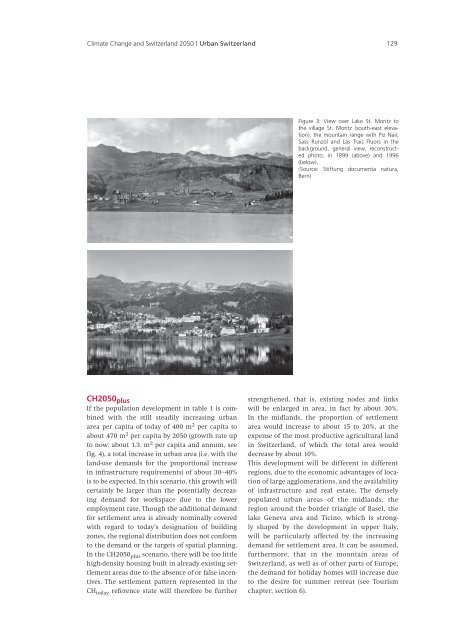Climate Change and Switzerland 2050 - OcCC - SCNAT
Climate Change and Switzerland 2050 - OcCC - SCNAT
Climate Change and Switzerland 2050 - OcCC - SCNAT
You also want an ePaper? Increase the reach of your titles
YUMPU automatically turns print PDFs into web optimized ePapers that Google loves.
<strong>Climate</strong> <strong>Change</strong> <strong>and</strong> Switzerl<strong>and</strong> <strong>2050</strong> | Urban Switzerl<strong>and</strong> 129<br />
CH<strong>2050</strong>plus<br />
If the population development in table 1 is combined<br />
with the still steadily increasing urban<br />
area per capita of today of 400 m 2 per capita to<br />
about 470 m 2 per capita by <strong>2050</strong> (growth rate up<br />
to now: about 1.3. m 2 per capita <strong>and</strong> annum, see<br />
fig. 4), a total increase in urban area (i.e. with the<br />
l<strong>and</strong>-use dem<strong>and</strong>s for the proportional increase<br />
in infrastructure requirements) of about 30–40%<br />
is to be expected. In this scenario, this growth will<br />
certainly be larger than the potentially decreasing<br />
dem<strong>and</strong> for workspace due to the lower<br />
employment rate. Though the additional dem<strong>and</strong><br />
for settlement area is already nominally covered<br />
with regard to today’s designation of building<br />
zones, the regional distribution does not conform<br />
to the dem<strong>and</strong> or the targets of spatial planning.<br />
In the CH<strong>2050</strong> plus scenario, there will be too little<br />
high-density housing built in already existing settlement<br />
areas due to the absence of or false incentives.<br />
The settlement pattern represented in the<br />
CH today reference state will therefore be further<br />
Figure 3: View over Lake St. Moritz to<br />
the village St. Moritz (south-east elevation),<br />
the mountain range with Piz Nair,<br />
Sass Runzöl <strong>and</strong> Las Trais Fluors in the<br />
background, general view, reconstructed<br />
photo, in 1899 (above) <strong>and</strong> 1996<br />
(below).<br />
(Source: Stiftung documenta natura,<br />
Bern)<br />
strengthened, that is, existing nodes <strong>and</strong> links<br />
will be enlarged in area, in fact by about 30%.<br />
In the midl<strong>and</strong>s, the proportion of settlement<br />
area would increase to about 15 to 20%, at the<br />
expense of the most productive agricultural l<strong>and</strong><br />
in Switzerl<strong>and</strong>, of which the total area would<br />
decrease by about 10%.<br />
This development will be different in different<br />
regions, due to the economic advantages of location<br />
of large agglomerations, <strong>and</strong> the availability<br />
of infrastructure <strong>and</strong> real estate. The densely<br />
populated urban areas of the midl<strong>and</strong>s, the<br />
region around the border triangle of Basel, the<br />
lake Geneva area <strong>and</strong> Ticino, which is strongly<br />
shaped by the development in upper Italy,<br />
will be particularly affected by the increasing<br />
dem<strong>and</strong> for settlement area. It can be assumed,<br />
furthermore, that in the mountain areas of<br />
Switzerl<strong>and</strong>, as well as of other parts of Europe,<br />
the dem<strong>and</strong> for holiday homes will increase due<br />
to the desire for summer retreat (see Tourism<br />
chapter, section 6).

















